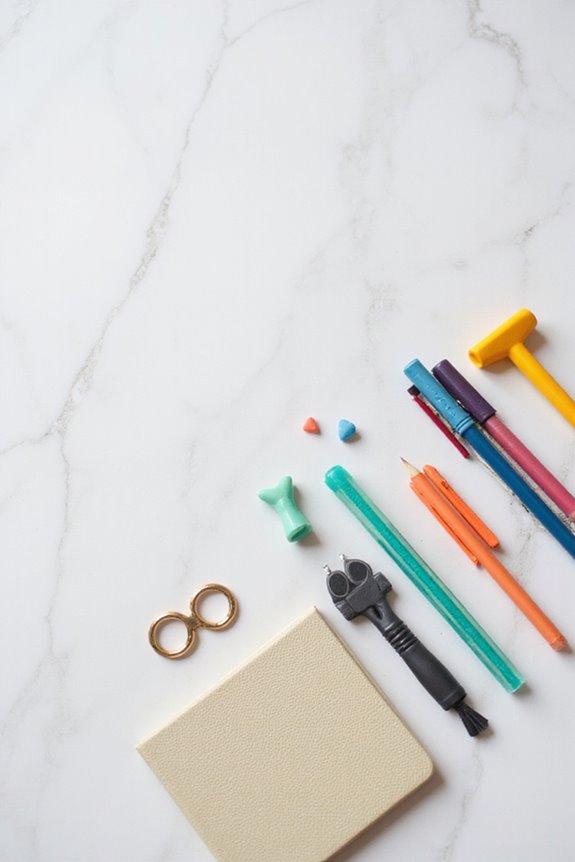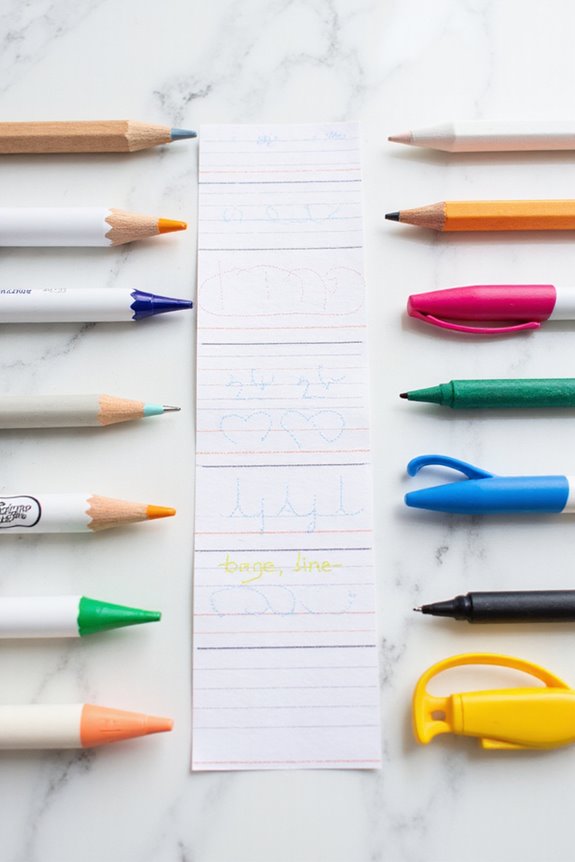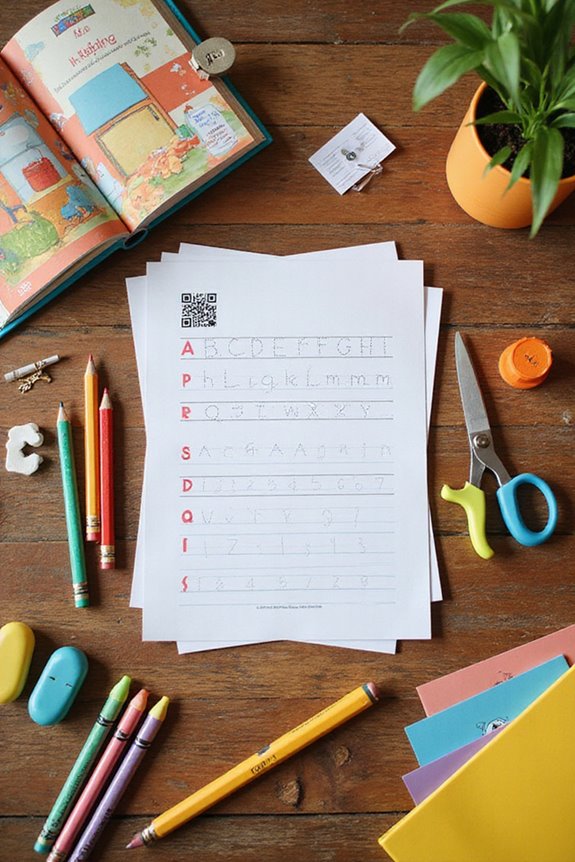When choosing writing tools for kids, we should consider their motor skills and sensory preferences. For example, markers can be a hit for those with fine motor challenges since they require less pressure. Ergonomic gel pens help reduce hand fatigue, and adaptive grips are great for comfort. It’s also important to encourage exploration with varied tools, like journals and digital platforms. Keep the excitement alive, and you’ll find plenty of resources to help kids thrive in their writing journey.
Key Takeaways
- Assess each child’s fine motor skills and sensory needs to select appropriate writing tools, considering grips and textures for comfort.
- Choose tools that match the child’s writing style, such as markers for those with fine motor challenges or ergonomic gel pens for longer sessions.
- Provide a variety of writing instruments and surfaces to stimulate interest, including journals, whiteboards, and colorful paper options.
- Incorporate both traditional and digital writing tools to maintain engagement and enhance motor skills through diverse practice opportunities.
- Ensure durability and comfort in writing tools, opting for high-quality materials that withstand consistent use and aid in developing writing skills.
Understanding Children’s Motor Skills and Sensory Needs

When we think about helping kids with their writing, it’s important to reflect on their motor skills and sensory needs. Fine motor skills are essential for handwriting, as they involve the coordination of small muscles in the hands and fingers. Children progress from whole-hand grasps to a more refined tripod grip, usually by age six. Engaging them in activities like grasping cereal or drawing can strengthen their hand dexterity. We should also consider sensory integration; some kids may need specific textures or grips to feel comfortable when writing. Offering varied tools and practices, such as textured surfaces or specific pencil grips, can support their writing journey, ultimately leading to more confident, legible handwriting. Regular practice with age-appropriate tools enhances skill retention and builds confidence in young writers.
Exploring Different Types of Writing Tools

Supporting young writers means understanding the tools that can make writing both easier and more enjoyable. When we explore different types of writing tools, we’ll find that pencils, pens, and markers are traditional favorites. Each offers unique benefits, like how markers need less pressure and are often preferred by kids with fine motor challenges. In our writing tool comparisons, adaptive options like grip aids and weighted pens also stand out, catering to kids with specific needs. Don’t forget about the fun tools, like Do-a-Dot markers or twistable crayons, which spark creativity! Digital tools like touchscreen pens and dry erase boards introduce an interactive twist, making practice engaging. By mixing various creative writing tools, we can support every budding author on their journey. For instance, using durable writing materials can significantly enhance a child’s handwriting development while providing the necessary support for fine motor skills.
Factors to Consider When Selecting Writing Instruments

Choosing the right writing instrument isn’t just about picking up a pen; it’s about finding the perfect match for your child’s unique needs. We need to take into account factors like writing comfort and pen durability. For instance, ergonomic gel pens can greatly reduce hand fatigue, making them ideal for long writing sessions. Let’s not forget handedness; left-handed kids might need special pens designed to minimize smudging and awkward angles. Also, nib type matters: ballpoint pens provide smooth writing for those still developing their rhythm. Durability’s key, too—kids can be rough! So, materials like quality plastic and sturdy erasers encourage consistent usage. By focusing on these factors, we can make sure our children have the best tools for their writing journey. Additionally, selecting high-quality paper can significantly enhance their overall writing experience and prevent tearing.
Strategies for Introducing Writing Tools Effectively

To introduce writing tools effectively, we need to create an environment that sparks curiosity and creativity in our children. First, let’s focus on tool placement; strategically placing writing materials like sticky notes and clipboards around the classroom invites exploration. Providing a variety of tools is equally important—think journals for creative writing and whiteboards for easy erasing and retrying. Offering various sizes and colors of paper can stimulate engagement, too. We can even engage children by allowing them to create their own labels, connecting spoken and written language. Remember, when we display their work prominently, it motivates them to keep writing. Encouraging personal storytelling alongside collaborative projects helps them see writing as an exciting expression. Additionally, connecting their writing to historical graffiti can inspire discussions about social issues and creativity.
Supporting Growth and Engagement in Writing Activities

Effective writing isn’t just about having the right tools; it’s also about how we engage children with these tools during writing activities. Incorporating both traditional and digital mediums can spark writing motivation and ignite creative expression. For instance, we can blend pencil-and-paper tasks with tablet apps to enhance motor skills while keeping kids engaged. Digital platforms can help kids share their work with a broader audience, adding excitement to their writing projects. Collaborative writing opportunities using tech can foster peer feedback, making the process interactive. Let’s also make use of apps that provide instant feedback, keeping learners motivated as they see their progress. By mixing approaches, we’re not just teaching writing; we’re making it fun and accessible for everyone. Additionally, using quality notebooks can encourage regular writing habits and enhance creativity in children.
Frequently Asked Questions
What Are the Signs My Child May Need Alternative Writing Tools?
We’ve noticed signs that our child might need alternative tools, like struggles with writing difficulties, frequent frustration, or poor legibility. Observing these behaviors can guide us in supporting their writing journey effectively.
How Can I Make Writing Tools More Accessible for My Child at Home?
Did you know 70% of kids learn better with organized supplies? By using storage with adjustable heights and incorporating sensory features, we can make writing tools more accessible and engaging for our children at home.
Are There Specific Brands Recommended for Children’s Writing Tools?
When we explore brand comparisons for children’s writing tools, we find product reviews highlighting Jasper AI and Scrivener as top choices. They provide age-appropriate content and simplify complex ideas, making writing fun and engaging for kids.
How Often Should I Change My Child’s Writing Tools for Effectiveness?
We shouldn’t focus on how often to change writing tools; instead, let’s consider writing frequency and each tool’s effectiveness. It’s more about matching tools to our child’s needs than merely rotating them regularly.
What Role Do Writing Tools Play in Developing Literacy Skills?
Writing tools play an essential role in our children’s writing development, enhancing their literacy skills. By engaging with various tools, we foster creativity and understanding, ultimately paving the way for their literacy enhancement and future success.





